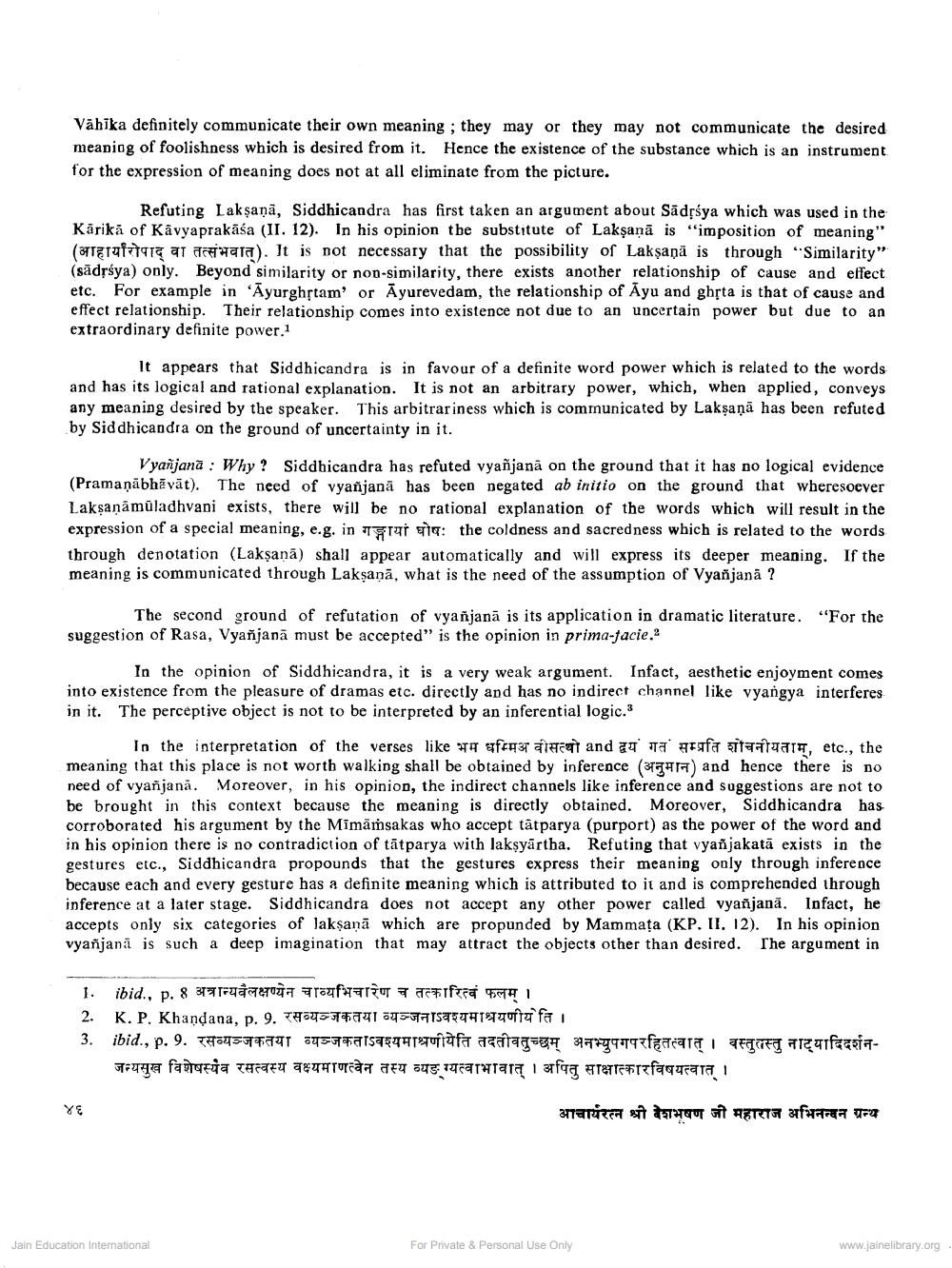________________
Vähika definitely communicate their own meaning; they may or they may not communicate the desired meaning of foolishness which is desired from it. Hence the existence of the substance which is an instrument for the expression of meaning does not at all eliminate from the picture.
Refuting Laksaņā, Siddhicandra has first taken an argument about Sādęśya which was used in the Kārikā of Kavyaprakāśa (II. 12). In his opinion the substitute of Laksaņā is "imposition of meaning" (arrutare ai ara). It is not necessary that the possibility of Lakşaņā is through "Similarity" (sādrsya) only. Beyond similarity or non-similarity, there exists another relationship of cause and effect etc. For example in 'Ayurghrtam' or Ayurevedam, the relationship of Ayu and gbrta is that of cause and effect relationship. Their relationship comes into existence not due to an uncertain power but due to an extraordinary definite power.1
It appears that Siddhicandra is in favour of a definite word power which is related to the words and has its logical and rational explanation. It is not an arbitrary power, which, when applied, conveys any meaning desired by the speaker. This arbitrariness which is communicated by Laksaņā has been refuted by Siddhicandra on the ground of uncertainty in it.
Vyañjana : Why? Siddhicandra has refuted vyañjanā on the ground that it has no logical evidence (Pramaņābhāvāt). The need of vyañjanā has been degated ab initio on the ground that wheresoever Laksaņāmüladhvani exists, there will be no rational explanation of the words which will result in the expression of a special meaning, e.g. in TTU 917: the coldness and sacredness which is related to the words through denotation (Lakşanā) shall appear automatically and will express its deeper meaning. If the meaning is communicated through Laksanā, what is the need of the assumption of Vyañjana ?
The second ground of refutation of vyañjanā is its application in dramatic literature. “For the suggestion of Rasa, Vyañjanā must be accepted" is the opinion in prima-facie.?
In the opinion of Siddhicandra, it is a very weak argument. Infact, aesthetic enjoyment comes into existence from the pleasure of dramas etc. directly and has no indirect channel like vyangya interferes in it. The perceptive object is not to be interpreted by an inferential logic.3
In the interpretation of the verses like भम धम्मिअवीसत्थो and द्वय गत सम्प्रति शोचनीयताम, etc., the meaning that this place is not worth walking shall be obtained by inference ( HT) and hence there is no need of vyañjana. Moreover, in his opinion, the indirect channels like inference and suggestions are not to be brought in this context because the meaning is directly obtained. Moreover, Siddhicandra has corroborated his argument by the Mimāmsakas who accept tātparya (purport) as the power of the word and in his opinion there is no contradiction of tātparya with lakṣyārtha. Refuting that vyañjakatā exists in the gestures etc., Siddhicandra propounds that the gestures express their meaning only through inference because each and every gesture has a definite meaning which is attributed to it and is comprehended through inference at a later stage. Siddhicandra does not accept any other power called vyanjanä. Infact, he accepts only six categories of Jakşanā which are propunded by Mammața (KP. II. 12). In his opinion vyañjanā is such a deep imagination that may attract the objects other than desired. The argument in
1. ibid., p. 8 31774 Frauf zur T ifa TF1 2. K. P. Khandana, p. 9. T45437474175971ST TATUUT fa 3. ibid., p. 9. #453 TOT 2437*159594170afa acaraa54 2778797facarti TFTTET Tulfasia
जन्यसुख विशेषस्यैव रसत्वस्य वक्ष्यमाणत्वेन तस्य व्यङ ग्यत्वाभावात् । अपितु साक्षात्कारविषयत्वात् ।
आचार्यरत्न श्री देशभषण जी महाराज अभिनन्दन ग्रन्थ
Jain Education International
For Private & Personal Use Only
www.jainelibrary.org




